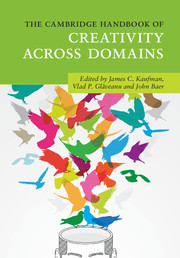Book contents
- The Cambridge Handbook of Creativity Across Domains
- The Cambridge Handbook of Creativity Across Domains
- Copyright page
- Dedication
- Contents
- Figures
- Tables
- Contributors
- Acknowledgments
- Part I Creativity and Domain
- Part II Creativity in the Traditional Arts
- Part III Creativity in the Sciences
- Part IV Creativity in Business
- 18 Studying Creativity across Different Domains
- 19 The Relationship Between Marketing and Creativity
- 20 Creative Leadership
- 21 Creativity in Business and Technology
- 22 Creativity in Design
- 23 A Minimalist Model for Measuring Entrepreneurial Creativity
- Part V Newer Domains for Creativity Research
- Part VI Creativity in Everyday Life
- Part VII Conclusion
- Index
- References
23 - A Minimalist Model for Measuring Entrepreneurial Creativity
from Part IV - Creativity in Business
Published online by Cambridge University Press: 15 September 2017
- The Cambridge Handbook of Creativity Across Domains
- The Cambridge Handbook of Creativity Across Domains
- Copyright page
- Dedication
- Contents
- Figures
- Tables
- Contributors
- Acknowledgments
- Part I Creativity and Domain
- Part II Creativity in the Traditional Arts
- Part III Creativity in the Sciences
- Part IV Creativity in Business
- 18 Studying Creativity across Different Domains
- 19 The Relationship Between Marketing and Creativity
- 20 Creative Leadership
- 21 Creativity in Business and Technology
- 22 Creativity in Design
- 23 A Minimalist Model for Measuring Entrepreneurial Creativity
- Part V Newer Domains for Creativity Research
- Part VI Creativity in Everyday Life
- Part VII Conclusion
- Index
- References
Summary
This esquisse of entrepreneurial creativity begins and ends with two Irishman: Richard Cantillon of the eighteenth century and Tony Ryan of the twenty-first century. “Entrepreneur,” a twentieth-century buzzword, has interesting etymological origins, including Anglo-Franco-Greek roots which contribute richly to better explain, understand, and define entrepreneurial creativity. A very succinct survey of some pertinent research literature highlights the great theoretical complexity when attempting to measure, in order to better define, entrepreneurial creativity. The theoretical complexity is found in the vast number of variations of indicators, aspects, parameters, and criteria proposed by experts and organizations, foundations and institutes. Most agree upon the imminent, even desperate, need for more universalism when conceiving models to better compare, understand, and define entrepreneurial creativity. There seems to be one thing everyone agrees upon – a distinct link between the creative behavior of entrepreneurs and their resulting success. Adopting a more French Cartesian approach means taking into consideration opposites when trying to understand something comprehensively. Is empirical simplicity the opposite of theoretical complexity? A daring attempt is made by the authors to propose a more universal model, hence simplistic and minimalist, for measuring and defining entrepreneurial creativity based on empirical experiences lived by real entrepreneurs. The authors propose a Minimalist Model respecting three criteria for measuring entrepreneurial creativity and applying it to the careers of three entrepreneurs from the British Commonwealth: Roy Thomson (Scottish-Canadian), Tony Ryan (Irish), and Richard Branson (English). The three criteria of the Minimalist Model are: Timing, Cognitive capacity, and Quantifiable changes.
- Type
- Chapter
- Information
- The Cambridge Handbook of Creativity across Domains , pp. 428 - 444Publisher: Cambridge University PressPrint publication year: 2017



